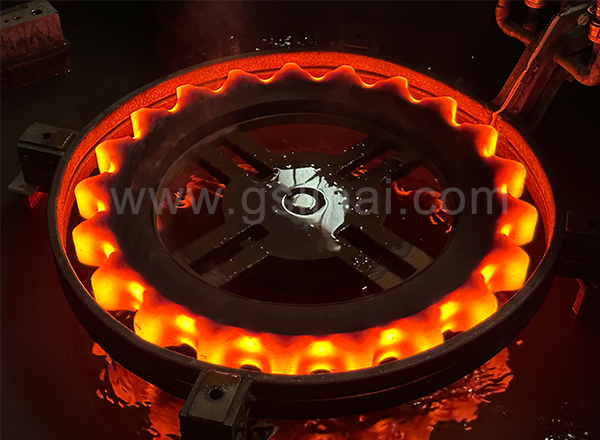Whether it is carburizing quenching, carbonitriding quenching, induction heating quenching or overall heating quenching, the heat treatment quality problems that may occur during the gear quenching and cooling process are mainly:
1. Insufficient hardness after quenching, uneven hardness in the quenched state, insufficient quenching hardening depth;
2. Too high hardness in the core after quenching;
3. Quenching deformation is too poor;
4. Quenching cracking;
5. Insufficient surface brightness after oil quenching.
This type of quality problem that occurs in the factory is often related to the material, pretreatment, quenching heating and quenching cooling of the gear. After eliminating the problems in material, pretreatment and heating, the role of quenching medium and related technologies is particularly prominent. In fact, foreign research on quenching and cooling in recent years has also proved that quenching and cooling are the most noteworthy in the work of improving and improving the quality of heat treatment.
Quenching cooling is mostly carried out in liquid media. Quenching oil, water-soluble quenching media and tap water are usually used for gear quenching. Therefore, the following will first analyze the relationship between the above quality problems that may occur in gear quenching cooling and the characteristics and usage of the quenching media used, and point out the cooling rate distribution characteristics of the quenching liquid required to solve different problems.
Quality problems in quenching and cooling
1. Insufficient hardness and insufficient hardening depth
The low quenching cooling speed is the reason for insufficient quenching hardness, uneven hardness and insufficient hardening depth of gears. However, according to the material, shape, size and heat treatment requirements of the actual quenched gears, it can be divided into insufficient cooling speed in the high temperature stage, insufficient cooling speed in the medium and low temperature stage, and insufficient cooling speed in the low temperature stage. For example. For small and medium-sized gears, insufficient quenching hardness is often caused by insufficient cooling speed in the medium and high temperature stage. When large-module gears require a deeper hardened layer, it is very necessary to increase the low-temperature cooling speed.
For quenching oil, generally speaking, the oil has a short vapor film stage, a fast medium temperature cooling rate, and a fast low temperature cooling rate, which can often obtain high and uniform quenching hardness and sufficient hardening depth.
The way the workpiece is mounted also has a significant impact on the quenching cooling effect. To achieve better results, the quenching oil must flow smoothly and a stirring device must be equipped and used properly.
Increasing the low-temperature cooling rate of the quenching medium used can often increase the depth of the hardened layer. Under the condition of the same carbon concentration distribution in the carburized layer, using a quenching oil with a higher low-temperature cooling rate often results in a deeper quenched hardened layer. Therefore, after using a quenching oil with a fast cooling rate, the carburizing time of the workpiece can be shortened accordingly, and the required quenched hardened layer depth can also be obtained. The greater the required carburized hardened layer depth, the more obvious the effect of this method in shortening the carburizing time.
2. The hardness of the core is too high after quenching
This type of problem may be related to the selected medium cooling rate being too fast or the medium's low-temperature cooling rate being too high. One solution is to change the quenching oil to meet the requirements. The second solution is to contact the quenching medium manufacturer and add appropriate additives to reduce the medium and low temperature cooling rate of the quenching oil. The third solution is to use a steel grade with lower hardenability.
3. Quenching deformation problem
Quenching deformation has caused a lot of headaches for many factories. Traditionally, the solution to the deformation problem usually involves multiple departments, and the solution is often a comprehensive measure.
Regarding the discussion of quenching deformation, we attributed the causes of deformation mainly to insufficient cooling rate and uneven cooling, and on this basis proposed the solution principle of increasing the cooling rate and trying to achieve uniform cooling. When applied, as long as the measures with the same direction of action are reasonably selected, the quenching deformation problems of most gears can be solved. For example, the deformation of the inner spline hole of the gear is often due to the insufficient high-temperature cooling rate of the selected quenching oil, or the excessively long vapor film stage of the oil. Increasing the high-temperature cooling rate of the oil and increasing the cooling rate of the oil during the entire cooling process can generally solve the deformation problem of the inner spline hole. For small and medium-sized gears, especially relatively precise gears, selecting and using isothermal graded quenching oil is an indispensable measure to control deformation.
4. Gear quenching cracking problem
This problem mainly occurs in induction heating quenching. Choose a good water-based quenching medium, such as the PAG quenching medium commonly used at home and abroad instead of the original tap water, and the problem will be solved. Induction heating quenching uses PAG medium. It can obtain high and uniform quenching hardness and deep and stable hardened layer, and the risk of quenching cracking is extremely small.
5. Brightness problem
When there is a requirement for this, bright quenching oil or fast bright quenching oil should be selected. Generally, if the brightness of bright quenching oil is good, the cooling rate is not high enough, and the brightness of quenching oil with a very high cooling rate is not good enough. In addition, the brightness of hot oil is generally poor, so you can replace the oil with new oil or add additives to improve the brightness.




 en
en  cn
cn  jp
jp  ko
ko  de
de  es
es  it
it  ru
ru  pt
pt  vi
vi  th
th  pl
pl 







 GS-ZP-1200
GS-ZP-1200


